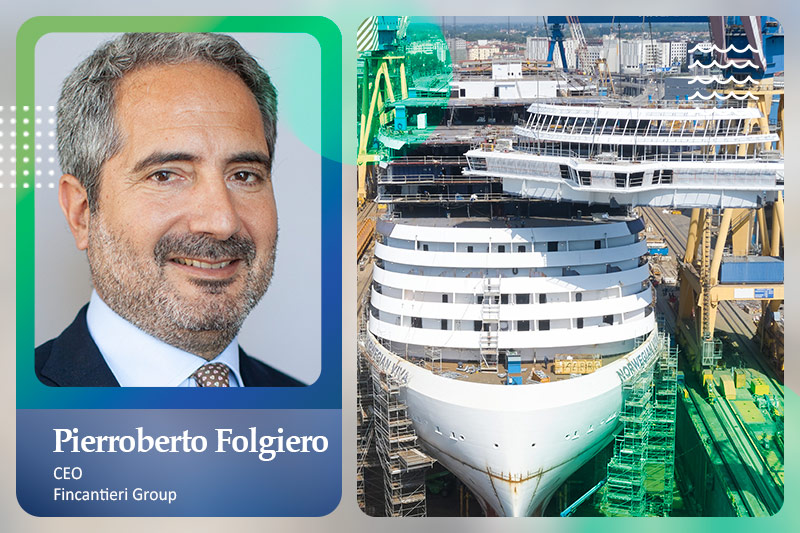Cross-fertilization drives innovation at the Fincantieri Group, according to CEO Pierroberto Folgiero, who referred to the company’s different business sectors for cruise, naval and offshore and specialized vessels, in addition to several subsidiaries in automation, engine manufacturing and more, including fuel cells for submarines.
“Cruise ships are of course very different from naval combat vessels, but the key to innovation is to have the creativity and courage to adapt applications in different types of ships, to cross-fertilize ideas and concepts,” he added.
“In my opinion, progress will be driven by integrators. By that I mean connecting the dots. It is not necessarily about inventing, it is not necessarily about being the owner of technology, but it is about integrating and adapting the best available state-of-the-art technologies to provide solutions to meet our clients’ expectations in terms of reducing fuel consumption and emissions, for example, while at the same time creating distinct products.”
The strategic plan also includes strengthening the company’s electro-mechanical competencies, including its knowledge of batteries, propellers and propulsion systems, in its core business segments, Folgiero explained, and make all this accumulated know-how available to the digital cruise ship.
Data Management
“Another aspect is the management of data,” Folgiero continued, “and Fincantieri has its own company, NexTech, which is working at the group level. It has historically been in charge of managing automation in the naval sector and is very good at managing sensors, preventive maintenance and more, what I call the industrial data, the operational technologies, that can be very useful for cruise ships.
“Our strategy is also based on teaming up and developing partnerships, not just client-supplier relationships, but real partnerships throughout the supply chain for key components whereby we enter joint engineering projects, investments and development of new ideas. Because at the end of the day we are ultimately interested in solutions, not owning the end-to-end supply chain,” he said.
Emissions Road Map
“We have designed our road map to reduce emissions by 32 to 33 percent, before touching engines and fuels,” Folgiero said. “We pursue every micro and macro opportunity. Examples include our patented air lubrication system, while we are also looking at covers for the thrusters, when they are not in use, along with new hull coatings, to improve the hydrodynamics, which means less friction in the water and lower fuel consumption and emissions.
“A second step will take us to a 55 percent reduction, which is the European Union target for 2030, and that will be achieved with LNG.”
Beyond the 55 percent reduction in emissions, Folgiero described it as an ecosystem exercise. While Fincantieri can be innovators and pioneers, he said the ecosystem needs to move in step with shipbuilding.
“Look at methanol, for example,” he said. “It can be used as a fuel for both combustion engines and fuel cells, and it is easier to manage than hydrogen. But it has to be produced in sufficient quantities and distributed to bunkering locations, and it should be green methanol, bio-methanol.”
Hydrogen
Hydrogen is also being explored by Fincantieri, but the biggest issue is that it has only one-fifth the energy content of traditional fuels, Folgiero noted.
Meanwhile, the company is testing a 5MW fuel cell with the equivalent hydrogen fuel storage, enabling a cruise ship to maneuver in and out of port without using its main engines.
Another project, supported by public funding, is focused on transforming LNG to hydrogen aboard a ship on a just-in-time basis. It would be a small steam reformer, which would be the chemical plant transforming LNG into hydrogen, which can be used in fuel cells or burned in combustion engines. The emissions would simply be steam; there will be no CO2.
However, producing hydrogen from LNG will produce CO2, so the same project calls for a CO2-capture plant and the liquefaction of the CO2 to be deposited ashore.
Sustainability
With 18 shipyards on four continents, including eight in Italy, Fincantieri is focused on environmental sustainability with such initiatives as substituting solar energy for traditional energy sources, Folgiero explained, who said plans call for installing solar panels at all of their facilities.
Moreover, he wants to install shore power at the yards, noting that a significant amount of CO2 emissions within the shipyards comes from ships’ engines which are turned on as soon as they are installed. With shore power, this source of emissions would be reduced significantly.
Other efforts are focused on minimizing the industrial waste streams as much as possible.
Future-proofing
“We are ahead of the game with our internal initiatives and by partnering with relevant companies to test and validate new ideas in order to provide new solutions to shipowners, Folgiero added.
“They are under a lot of pressure, having to make decisions that will make sense over the next 30 years. The question is what technologies can you bet on to last 30 years?
“That is where we come in. Fincantieri can be a reliable industrial partner and support shipowners when making these decisions.”
At press time, Fincantieri had 23 cruise ships on its orderbook through 2028.
Excerpt from the Cruise Industry News Quarterly Magazine Fall 2023




